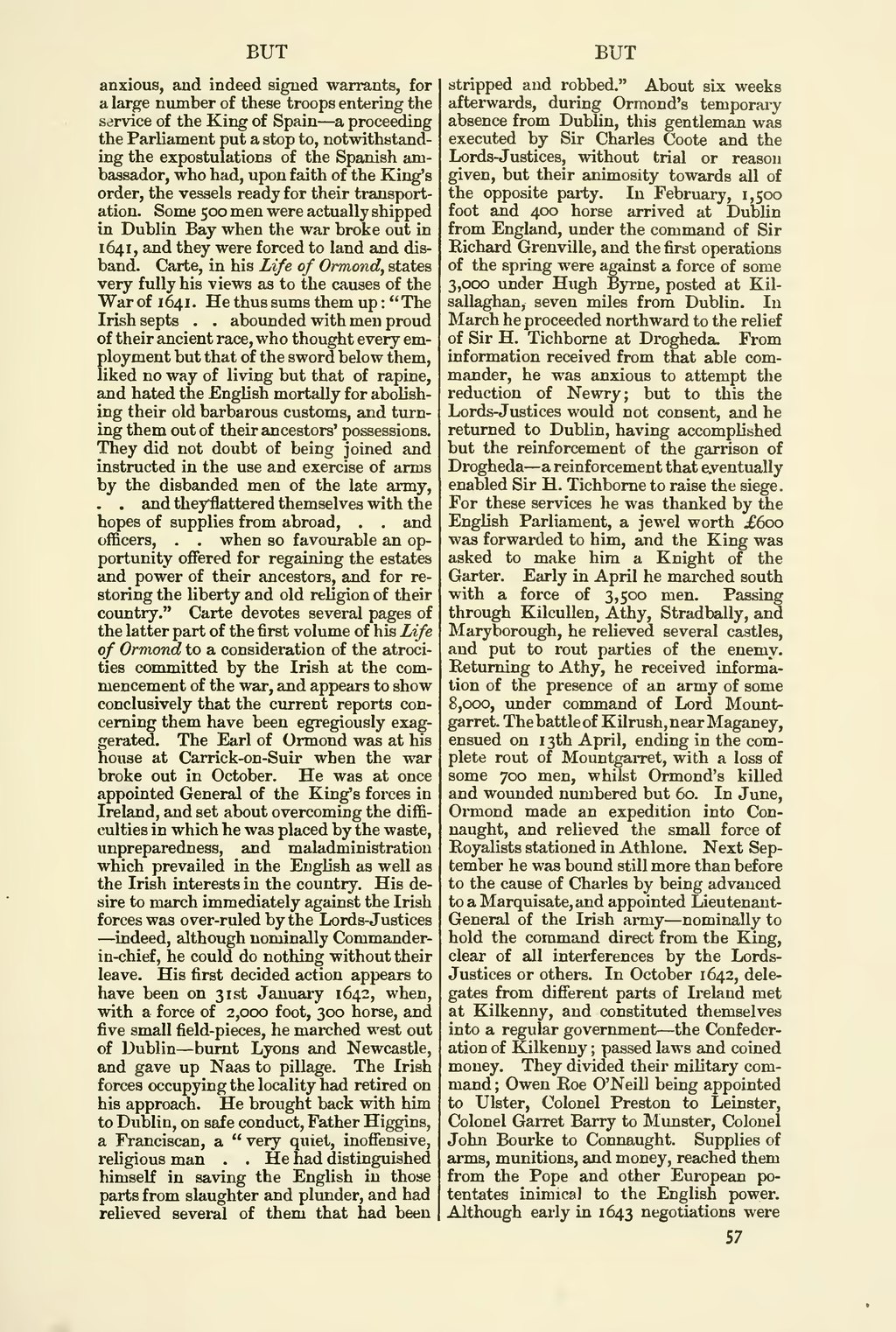anxious, and indeed signed warrants, for a large number of these troops entering the service of the King of Spain—a proceeding the Parliament put a stop to, notwithstanding the expostulations of the Spanish ambassador, who had, upon faith of the King's order, the vessels ready for their transportation. Some 500 men were actually shipped in Dublin Bay when the war broke out in 1641, and they were forced to land and disband. Carte, in his Life of Ormond, states very fully his views as to the causes of the War of 1641. He thus sums them up: "The Irish septs … abounded with men proud of their ancient race, who thought every employment but that of the sword below them, liked no way of living but that of rapine, and hated the English mortally for abolishing their old barbarous customs, and turning them out of their ancestors' possessions. They did not doubt of being joined and instructed in the use and exercise of arms by the disbanded men of the late army, … and they flattered themselves with the hopes of supplies from abroad, … and officers, … when so favourable an opportunity offered for regaining the estates and power of their ancestors, and for restoring the liberty and old religion of their country." Carte devotes several pages of the latter part of the first volume of his Life of Ormond to a consideration of the atrocities committed by the Irish at the commencement of the war, and appears to show conclusively that the current reports concerning them have been egregiously exaggerated. The Earl of Ormond was at his house at Carrick-on-Suir when the war broke out in October. He was at once appointed General of the King's forces in Ireland, and set about overcoming the difficulties in which he was placed by the waste, unpreparedness, and maladministration which prevailed in the English as well as the Irish interests in the country. His desire to march immediately against the Irish forces was over-ruled by the Lords-Justices—indeed, although nominally Commanderin-chief, he could do nothing without their leave. His first decided action appears to have been on 31st January 1642, when, with a force of 2,000 foot, 300 horse, and five small field-pieces, he marched west out of Dublin—burnt Lyons and Newcastle, and gave up Naas to pillage. The Irish forces occupying the locality had retired on his approach. He brought back with him to Dublin, on safe conduct. Father Higgins, a Franciscan, a "very quiet, inoffensive, religious man … He had distinguished himself in saving the English in those parts from slaughter and plunder, and had relieved several of them that had been stripped and robbed." About six weeks afterwards, during Ormond's temporary absence from Dublin, this gentleman was executed by Sir Charles Coote and the Lords-Justices, without trial or reason given, but their animosity towards all of the opposite party. In February, 1,500 foot and 400 horse arrived at Dublin from England, under the command of Sir Richard Grenville, and the first operations of the spring were against a force of some 3,000 under Hugh Byrne, posted at Kilsallaghan, seven miles from Dublin. In March he proceeded northward to the relief of Sir H. Tichborne at Drogheda. From information received from that able commander, he was anxious to attempt the reduction of Newry; but to this the Lords-Justices would not consent, and he returned to Dublin, having accomplished but the reinforcement of the garrison of Drogheda—a reinforcement that eventually enabled Sir H. Tichborne to raise the siege. For these services he was thanked by the English Parliament, a jewel worth £600 was forwarded to him, and the King was asked to make him a Knight of the Garter. Early in April he marched south with a force of 3,500 men. Passing through Kilcullen, Athy, Stradbally, and Maryborough, he relieved several castles, and put to rout parties of the enemy. Returning to Athy, he received information of the presence of an army of some 8,000, under command of Lord Mountgarret. The battle of Kilrush, near Maganey, ensued on 1 3th April, ending in the complete rout of Mountgarret, with a loss of some 700 men, whilst Ormond's killed and wounded numbered but 60. In June, Ormond made an expedition into Connaught, and relieved the small force of Royalists stationed in Athlone. Next September he was bound still more than before to the cause of Charles by being advanced to a Marquisate, and appointed Lieutenant-General of the Irish army—nominally to hold the command direct from the King, clear of all interferences by the Lords-Justices or others. In October 1642, delegates from different parts of Ireland met at Kilkenny, and constituted themselves into a regular government—the Confederation of Kilkenny; passed laws and coined money. They divided their military command; Owen Roe O'Neill being appointed to Ulster, Colonel Preston to Leinster, Colonel Garret Barry to Munster, Colonel John Bourke to Connaught. Supplies of arms, munitions, and money, reached them from the Pope and other European potentates inimical to the English power. Although early in 1643 negotiations were
